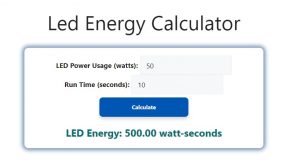About Led Energy Calculator (Formula)
The LED Energy Calculator is an essential tool for both homeowners and businesses who want to monitor and optimize their energy usage. As LED lighting becomes increasingly popular due to its energy efficiency and longevity, understanding how much energy these fixtures consume is vital. This calculator allows users to estimate the energy consumption of their LED lights based on their power usage and runtime, which can lead to significant cost savings.
Formula
The formula for calculating LED energy consumption is:
LED Energy (Eled) = LED Power Usage (Pled) * Run Time (T)
Where:
- LED Energy (Eled) is the total energy consumed by the LED in kilowatt-hours (kWh).
- LED Power Usage (Pled) is the power rating of the LED bulb in watts (W).
- Run Time (T) is the duration the LED light is on, measured in hours (h).
How to Use
Using the LED Energy Calculator is straightforward. Here’s how to do it:
- Identify LED Power Usage: Check the wattage of your LED light bulb, which is usually listed on the packaging or on the bulb itself.
- Determine Run Time: Estimate how many hours the LED light will be on during a specific period (daily, weekly, or monthly).
- Input Values: Enter the power usage (in watts) and the run time (in hours) into the calculator.
- Calculate Energy Consumption: Click the “Calculate” button to determine the energy consumption in kilowatt-hours.
Example
For instance, if you have an LED bulb that consumes 10 watts and you use it for 5 hours a day, you can calculate the energy consumption as follows:
Using the formula:
LED Energy (Eled) = LED Power Usage (Pled) * Run Time (T)
LED Energy (Eled) = 10 W * 5 h = 50 Wh per day
To convert watt-hours to kilowatt-hours (1 kWh = 1000 Wh):
LED Energy (Eled) = 50 Wh / 1000 = 0.05 kWh per day
If you want to calculate the monthly usage:
Monthly Energy Consumption = 0.05 kWh/day * 30 days = 1.5 kWh

FAQs
- What is LED energy consumption?
LED energy consumption refers to the amount of electrical energy used by an LED light bulb over time. - How is energy consumption measured?
Energy consumption is typically measured in kilowatt-hours (kWh), which indicates how much energy a device uses over a specified time period. - Why should I use an LED energy calculator?
It helps you estimate your energy usage and potential savings by switching to LED lighting. - What factors influence LED energy consumption?
The wattage of the bulb and the duration of use significantly influence energy consumption. - How can I reduce energy consumption with LED lights?
Use lower wattage bulbs, reduce run time, or install dimmer switches to minimize energy usage. - Is the energy consumption of LED lights lower than incandescent bulbs?
Yes, LED lights consume significantly less energy than incandescent bulbs for the same light output. - Can I use this calculator for other types of lighting?
While primarily designed for LEDs, the calculator can also be used for other types of lighting by adjusting the power usage. - What is the lifespan of an LED bulb?
LED bulbs typically last between 15,000 to 50,000 hours, much longer than traditional bulbs. - How do I convert watts to kilowatts?
To convert watts to kilowatts, divide the wattage by 1,000 (1 kW = 1000 W). - Can the calculator help me compare costs?
Yes, by estimating energy usage, you can compare costs between different lighting options. - What are some common wattages for LED bulbs?
Common wattages for LED bulbs range from 5W to 15W for standard household use. - Is the energy consumption the same for all LED bulbs?
No, energy consumption varies based on the bulb’s wattage and design. - How does dimming affect energy consumption?
Dimming an LED bulb can reduce its energy consumption, but the effect may vary by bulb type. - What is the cost of electricity used by LED lights?
To calculate the cost, multiply the energy consumption (in kWh) by your local electricity rate. - Can LED bulbs be recycled?
Yes, many LED bulbs can be recycled, but check local guidelines for disposal. - Do LED lights emit heat?
LED lights emit much less heat compared to incandescent or halogen bulbs, making them safer to use. - Are LED bulbs worth the investment?
Yes, although they may have a higher upfront cost, the energy savings and longevity make them cost-effective in the long run. - How do I know if my LED bulbs are energy efficient?
Look for Energy Star ratings or similar certifications, which indicate high energy efficiency. - What if I use my LED lights for different durations?
You can calculate energy consumption separately for each duration and add them together for total usage. - Is there a difference between wattage and lumens?
Yes, wattage measures energy consumption, while lumens measure brightness. Higher lumens mean brighter light, regardless of wattage.
Conclusion
The LED Energy Calculator is a vital tool for anyone looking to manage energy usage effectively. By understanding how to calculate the energy consumption of LED lights, users can make informed decisions about their lighting choices, leading to cost savings and reduced environmental impact. With the continued advancement of LED technology, using this calculator can help you maximize the benefits of energy-efficient lighting in your home or business.